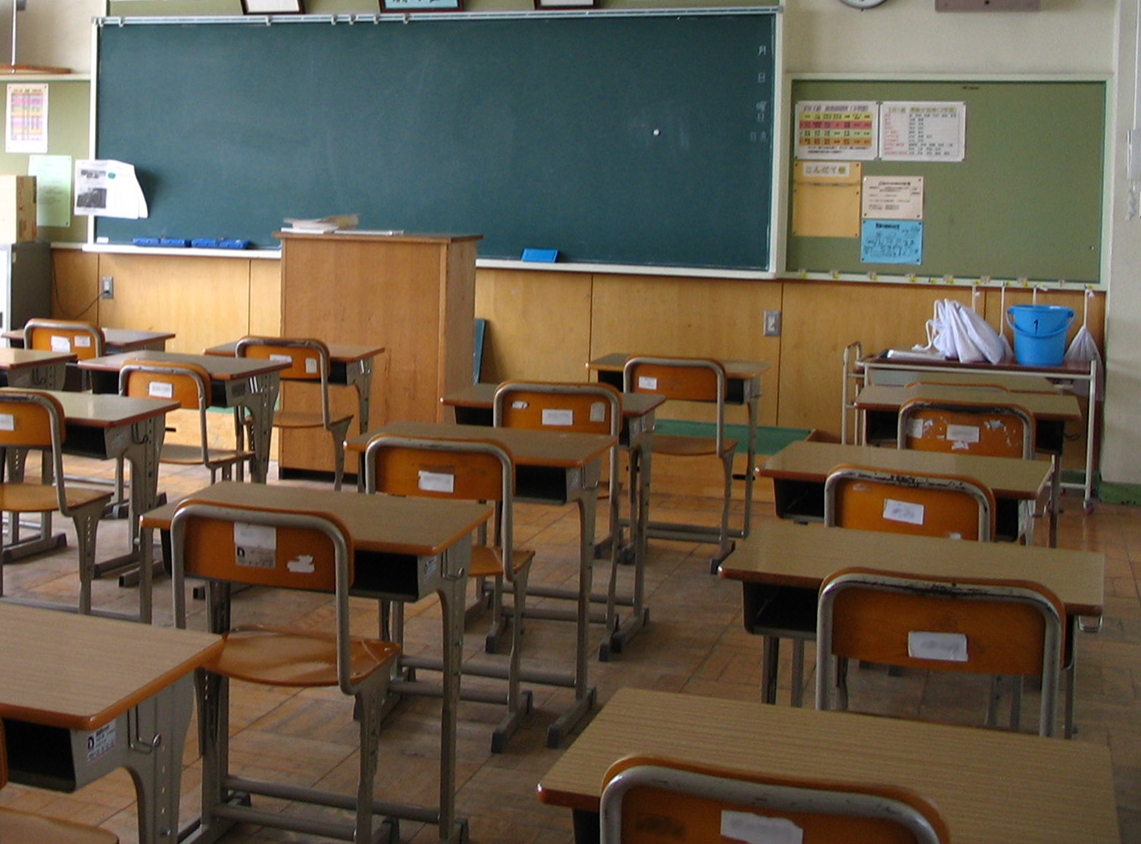Education
‘No Excuses’: Can a Return to Traditional Discipline Save Public Schools?

COLUMBUS, Ohio—On a bright morning in May at the Columbus Collegiate Academy Main, orderliness is on display. Students in khakis and blue tops carrying bulging backpacks walk briskly in line through the front doors of the single-story brick building – looking like young people who really want to be there.
The wonderful effect of orderly behavior and its enforcement
In class after class, the predominantly black and Latino student body appears seriously engaged, with pencils in hand or fingers on keyboards. Teachers move rapidly through lessons. Hands shoot up to answer questions. No one is fooling around or disturbing others, which seems remarkable for a middle school full of teenagers.
The academy is one of an estimated 1,000high-performing urban charters that run on the No Excuses model. Its firm rules for behavior require students to sit up at their desks, remain silent unless called upon, and respect each other, which creates calm conditions for learning.
After another year of disarray in many urban public schools, with the vast majority of teachers reporting that behavior issues were their biggest challenge, proponents say No Excuses charters provide an example of how to restore order and learning.
Instead, they have been banished to the sidelines of public education. Progressive educators who have embraced “anti-racism” as their guiding principle over the last five years have assailed the charters, claiming they single out students of color for stern discipline. The rhetoric has been inflammatory, alleging that the charters “control black bodies” and prepare students for prison, despite the high rate of No Excuses graduates who go on to college.
Where did the No Excuses idea come from?
The term No Excuses was coined in the 1990s as a plea for educators to stop using excuses, such as poverty and broken homes, for the turmoil in urban schools that made learning impossible. A group of teachers, including David Levin of the charter network KIPP, brought together ideas from their experiences to fashion a new kind of urban school with a culture of high academic expectations and a precise set of rules and consequences to help students reach them.
Today, the slogan No Excuses is so controversial that many charters avoid it, even while continuing its practices. Other charter networks, like Achievement First, have completely abandoned the No Excuses model and joined the anti-racism crusade, only to see their performance plummet after ratcheting back discipline and lowering academic standards to ensure students pass courses and graduate.
Not perfect, but growing
No Excuses leaders admit they made mistakes early on in their zeal to improve urban education. Some networks, such as KIPP, pushed discipline too far by publicly shaming students, a stain on the movement’s record. Others, like Ascend Learning, depended on rote instruction that discouraged students from thinking for themselves and developing the inquisitiveness and agency they would need to succeed in college and beyond.
The criticism spurred many No Excuses charters to change, becoming less rule-bound and more student-led, says Steven Wilson, the founder of Ascend Learning.
“One of the things that I admire about these high-performing charters is that they are constantly willing to criticize themselves and evolve,” said Wilson, whose book about how anti-racism doctrine is replacing academic instruction will be published this fall. “No Excuses practices could really help traditional schools struggling with high levels of misbehavior if they were willing to evolve, too.”
But one core principle of No Excuses hasn’t changed, according to Doug Lemov, author of a popular No Excuses teaching manual entitled “Teach Like a Champion”: Equity for marginalized students starts with their high achievement in school.
A Day at Columbus Collegiate Academy
What sets No Excuses schools apart is the priority they place on creating a culture of high expectations that’s constantly reinforced. Students at the Columbus academy hear daily pep talks over the public address system about hard work leading to success. They strive to be included among the names of students who are learning rapidly that are posted in the hallway. They also look up at the dozens of college pennants hanging on walls, reminding them to keep their eye on the prize.
Teachers also must buy in to the demanding culture by acting with urgency in almost everything they do. Urgency is a key concept in No Excuses, as if there isn’t a minute to lose in educating these students who enter the school several years behind grade level.
Lessons are tightly scripted to the clock to squeeze in as much learning as possible. Teachers, rather than students, move through the shiny, clean hallways from classroom to classroom during the day because it takes less time and creates less commotion. Kids change rooms for classes like physical education.
Building the No Excuses culture starting on day one
Culture-building begins immediately at the start of each year. In the first three days of school, called “culture camp,” students learn the rules of behavior, such as keeping their eyes on the teacher and a pencil at the ready, and why those rules are key to meeting the high academic standards. Then they practice these skills, like how to show respect to teachers and peers, before they open a textbook.
“It’s important to be very explicit to students about the expectations and why they are necessary,” said Andy Boy, CEO of United Schools Network, which operates the Columbus academy. “They feel a sense of relief in that it takes the guesswork out of how to become successful students.”
During the year, the charter uses a paycheck system, with students receiving “dollars” for good behavior and losing them for misbehavior. At the end of each week, kids earning a lot of money can buy items at the school store, dress down in T-shirts, and have fun at the school party on Friday. The money system works, with about 85% of 8th graders making the party cutoff each week, says science teacher Alex Retodo.
Students who earn three deductions in a single class are sent to the culture office, where they talk with staff about why they are acting out and how it disturbs other students. The goal is to quickly get them back in class, and they often return within 20 minutes.
Structure and consistency
“I really like the structure, there are no gray areas, and it’s the same throughout the school,” says Retodo, who gave up plans for medical school to devote herself to the academy. “The consequences do help students learn how to control themselves in ways that will be productive for them.”
Tyriana Holyfield transferred to the academy in 2023 to escape the rowdiness, bullying, and lack of rigor at a traditional middle school called Buckeye. Holyfield says Buckeye students repeatedly pressured her to stop working hard in class to get good grades, a striving that some black students disparage as “acting white.” Despite her pleas to teachers to intervene, the bullying continued. “There was no discipline,” she says. “And I wasn’t being challenged in class either.”
At the Columbus academy, Holyfield has found a more rigorous school where she is excelling. Teachers show they care by pushing her to do better in class, something she hadn’t experienced before. There’s homework most nights. “I do want to go to college and be a good example for my five siblings,” said Holyfield, whose mom works at a nail salon.
United’s schools haven’t been immune to the fallout of the pandemic lockdowns. The extra pressure on teachers, plus the relatively low starting salary, which was recently raised to $49,000, led to an exodus of teachers in 2022-23 and a jump in suspensions. But this school year, both problems receded. At the Columbus academy, 27% of students served at least one suspension this school year.
Academic results
United’s academic results are what make the network of 815 students stand out. In 2019, its three charters outperformed the public schools in their neighborhood on state tests by at least 20 percentage points, an enormous gap. Through the tough pandemic times, two of the United schools widened their lead by 2023.
“We outscored them because we work hard and stuck with our mission of high expectations even though it is not super popular,” says Diana Wakim, chief advancement officer at United.
No More No Excuses
Other charters like KIPP, the biggest network in the country with 275 schools, buckled under the pressure from progressive staffers, alums, and advocates to drop their No Excuses practices.
Two months after the police murder of George Floyd in 2020 gripped the nation, Levin, the KIPP co-founder, famously issued a public letter, apologizing that its discipline practices “perpetuated white supremacy and anti-Blackness” and underscoring his commitment to restorative justice and racial equity. KIPP also dropped its “Work Hard, Be Nice” slogan, since it was seen as bolstering a myth that hard work leads to success even in the face of racism.
KIPP DC, one branch of the national network, embraced Levin’s “anti-racist” message and suffered academically because of it, says Anaka Osborne, who taught at its AIM middle school for six years. Osborne says the school went from using an effective and balanced No Excuses approach, with teachers demanding much of students but also cutting them a break when problems emerged at home, to a culture of coddling – both during and after the pandemic.
After KIPP DC lowered academic standards and jettisoned its ladder of consequences that had kept classrooms calm, Osborne, who is black and Filipino, decided to quit. “Students were making minimal effort and were passed along,” she said. “When schools lower the bar for black and Latino students, that in itself is racist.”
And then the unraveling
Today, KIPP DC is no longer an academic powerhouse. In 2019, its schools on average outperformed the public school district in math and English. Last year, KIPP DC trailed far behind the district, with only 13% proficiency in math and 18% in English. Levin and KIPP DC did not respond to requests for comment.
Achievement First, a network of 41 schools in New York, Connecticut, and Rhode Island, also unraveled.
It rode a No Excuses program to higher and higher test scores in the five years before the pandemic. The co-founders took the assessments seriously and were key to helping teachers figure out how to improve instruction, according to a former senior leader at Achievement First. In 2019, the charters outperformed the public schools in their three states by double-digit margins, underscoring the Achievement First name.
But as the network adopted what proponents call the anti-racist agenda, its views on testing changed. School leaders said performance on tests would no longer be such a high priority because it doesn’t “tell the full story of student growth,” according to a 2022 memo to staff that was sent after scores plunged. The full story would now stress social and emotional learning and student experience.
Big mistake: sacrificing discipline
Network leaders prioritized reducing suspensions over academics. This meant ditching the discipline system with consequences for unruly behavior and replacing it with “restorative justice” practices, the former senior leader said. The high academic expectations also disappeared: Struggling students who under No Excuses would have been held back, amounting to about 7% of kids, were now all promoted to the next grade.
“Students can basically do whatever they want, and nothing really happens to them,” said the source, who resigned because he opposed the changes. “The less experienced teachers have seen their classrooms descend into chaos.”
Achievement First schools are no longer envied for their performance, with test scores in Connecticut and Rhode Island plunging below the state public school averages. In Rhode Island, for instance, the charters in 2019 topped the state in English and math proficiency by 17 and 23 percentage points, respectively. In 2023, under an anti-racism program, the charters lagged behind by three and four percentage points.
Achievement First’s website does boast that U.S. News & World Report ranks its Hartford High as No. 3 and Amistad High as No. 12 in Connecticut, without providing the year. In the 2024 rankings, Amistad is No. 45 and Hartford didn’t make the top 100 cut. Achievement First did not respond to requests for comment.
The Evolution of No Excuses
The No Excuses schools that stood their ground in the face of progressive pressure have had a much stronger run through the pandemic. But they have also evolved.
Education scholar Joanne Golann, who embedded herself in a No Excuses charter a decade ago and wrote a book about it, “Scripting the Moves,” raised serious questions about whether all the rules were blunting the assertiveness of the students. After finding success by following the No Excuses playbook, would these students thrive when left to their own devices in college? Would they have the gumption to challenge the racism they encountered at work or just submit to authority, as they did in school?
“Students who were told what to do all the time in No Excuses schools said it didn’t translate well to the college environment, where they needed to be independent, make their own decisions, and speak up in class,” Golann said.
Wilson, the Ascend founder, says he took Golann’s critique to heart, making changes to give students more “agency and voice” over their education. After students abided by a system that gave them frequent feedback about their behavior in elementary school, they were tired of it and ready for more freedom in middle school. So Ascend dropped its feedback system but kept its high expectations and found that behavior improved because students had learned how to govern themselves, says Wilson.
Introducing inquiry before disciplinary sanctions
The Columbus academy retained its behavior grading system but in a modified form. It eased up on rules in recognition that students from poor families need more support. Rather than immediately giving students a deduction for falling asleep in class, for instance, teachers now tell them to take a break, and try to find out if they are having problems at home, says English teacher Jenn Felbaum. Penalties were also dropped for small matters, such as not wearing the proper clothing or not bringing a pencil to school. Equally significant, No Excuses charters also dispensed with their style of instruction that gave teachers maximum control over learning. Teachers had used a didactic approach, showing students how a problem is solved and then asking them to solve it themselves.
Now teachers ask students to struggle through the problem themselves and collaborate with classmates to find answers before they lend a hand. No Excuses leaders say the approach builds self-reliance in students and better prepares them for college.
Celebration of achievement
Brooke, a charter network in Boston that uses some No Excuses practices, says its college-prep program “puts the thinking on kids.” Its predominately black and Latino students are encouraged to believe that, through hard work, they can be high achievers and go to college. All high school students are required to take at least three AP classes, a practice not found in traditional public schools. Last year, Brooke was the highest-performing open-enrollment high school in Boston.
Since Brooke’s first graduating class in 2020, 84% of its students started two- and four-year college programs the semester after graduating, far exceeding the percentage for Boston public schools in 2021. At Brooke’s college signing day celebration, students announce the college they are going to, and everyone in the room is psyched for them, says Kimberly Steadman, Brooke’s co-director.
“We deeply believe all kids can achieve, and we develop this confidence in them by talking about it all the time and celebrating their academic achievements,” said Steadman.
Ripe for Expansion?
The final test of No Excuses charters is the all-important college graduation rate of their students. Nationwide, only about 11% of students from low-income families graduate college in six years. KIPP did much better, reporting a rate of 39%, based on students who graduated high school before some of its charters entirely dropped No Excuses.
Success Academy, the star of the No Excuses movement, credits its remarkable rate of more than 80%, which tops the national average for all students, to the 13 advanced placement classes all kids must take starting in middle school and five exams they must pass to graduate.
“Success Academy is the most No Excuses of them all,” said Robert Pondiscio, the author of a book about New York City’s largest charter network called “How the Other Half Learns.” “It has the most cohesive culture I have ever seen, and when you nail the culture, almost any program will work.”
To be sure, not all No Excuses schools are high performers. Some are unable to complete the difficult task of building strong cultures where students can thrive. But they remain very popular with families. Parents see them as safe havens free from the bedlam of other public schools. Some like Brooke have waiting lists. The United network is gearing up to expand in the next few years.
Returning to No Excuses
In a sign that No Excuses may be ripe for a rebound, some charters that turned away from its disciplinary practices are realizing that was a mistake, says Sue Walsh, a former No Excuses school leader.
“Well-intended educators embraced a lot of antiracist practices that don’t work,” said Walsh, who consults with charters. “And a goodly number of them are rethinking those moves and coming back to No Excuses.”
This article was originally published by RealClearInvestigations and made available via RealClearWire.
Vince Bielski is a self-employed free-lance journalist. His favorite subjects are the environment, green energy, education, and immigration.
-

 Civilization4 days ago
Civilization4 days agoTrump’s Venezuela Gamble and America’s Shifting National Security Strategy
-

 Civilization4 days ago
Civilization4 days agoOperation Absolute Resolve: Anatomy of a Modern Decapitation Strike
-

 Civilization3 days ago
Civilization3 days agoTen Reasons To Cheer the Arrest of Maduro
-

 Civilization5 days ago
Civilization5 days agoTrump delivers deeds, not words
-

 Civilization1 day ago
Civilization1 day agoOne Fell Swoop: Lawsuit Eyes Death Blow to Racial Preferences
-

 Executive2 days ago
Executive2 days agoWaste of the Day: $1.6T in Wasteful Spending in Rand Paul’s “Festivus” Report
-

 Civilization3 days ago
Civilization3 days agoTrump’s New Executive Order on Space Has the Right Stuff
-

 Guest Columns2 days ago
Guest Columns2 days agoAdvice to Democrats Regarding Maduro Arrest: Resist Reflexive Opposition












